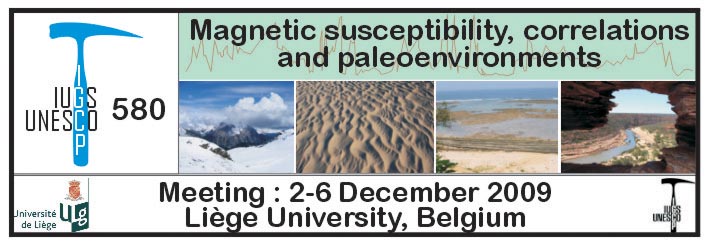IGCP 580 - Magnetic susceptibility, correlations and palaeoenvironments
Contact: Anne-Christine da Silva (ac.dasilva@ulg.ac.be), University of Liège, Belgium
Project web-site: http://www2.ulg.ac.be/geolsed/MS/news.htm.
Quantitative magnetic susceptibility (MS) measurements have become widely used in the sedimentology of rocks from the Recent to the Paleozoic. The basic principle of the technique is the following: MS measurements on sedimentary rocks are considered as a proxy for impurities delivered to the sedimentary environments. Although the common sandstones or limestones have very low magnetic response, many weathering products coming from the erosion of the main land commonly have high MS values. So the measurement of MS in sediment is considered as a proxy for such detrital input. This relationship is interesting because it is hypothetized that climatic and eustatic sea level variations will affect the detrital input. A sea-level fall increases the proportion of exposed continent and siliciclastic supply and therefore increases magnetic mineral deposition. Furthermore, an increase of rainfall or a glaciation will also increase erosion. Bulk MS measurements have been used in sedimentology for correlations and for reconstruction of sea level or climatic changes.

The interdisciplinary IGCP-project 850, funded by the UNESCO, aims is to compile published magnetic susceptibility records from Palaeozoic sedimentary rocks and to acquire new data for testing the correlation between susceptibility and sedimentological parameters. Another goal is to investigate the cause of the magnetic susceptibility signal in different sedimentary environments and its relationship to climate controlled environmental parameters. Finally, magnetic susceptibility records from different globally distributed sites will be correlated for reconstructions of past climatic variations. For this purpose, we invite all interested scientists to join the project.